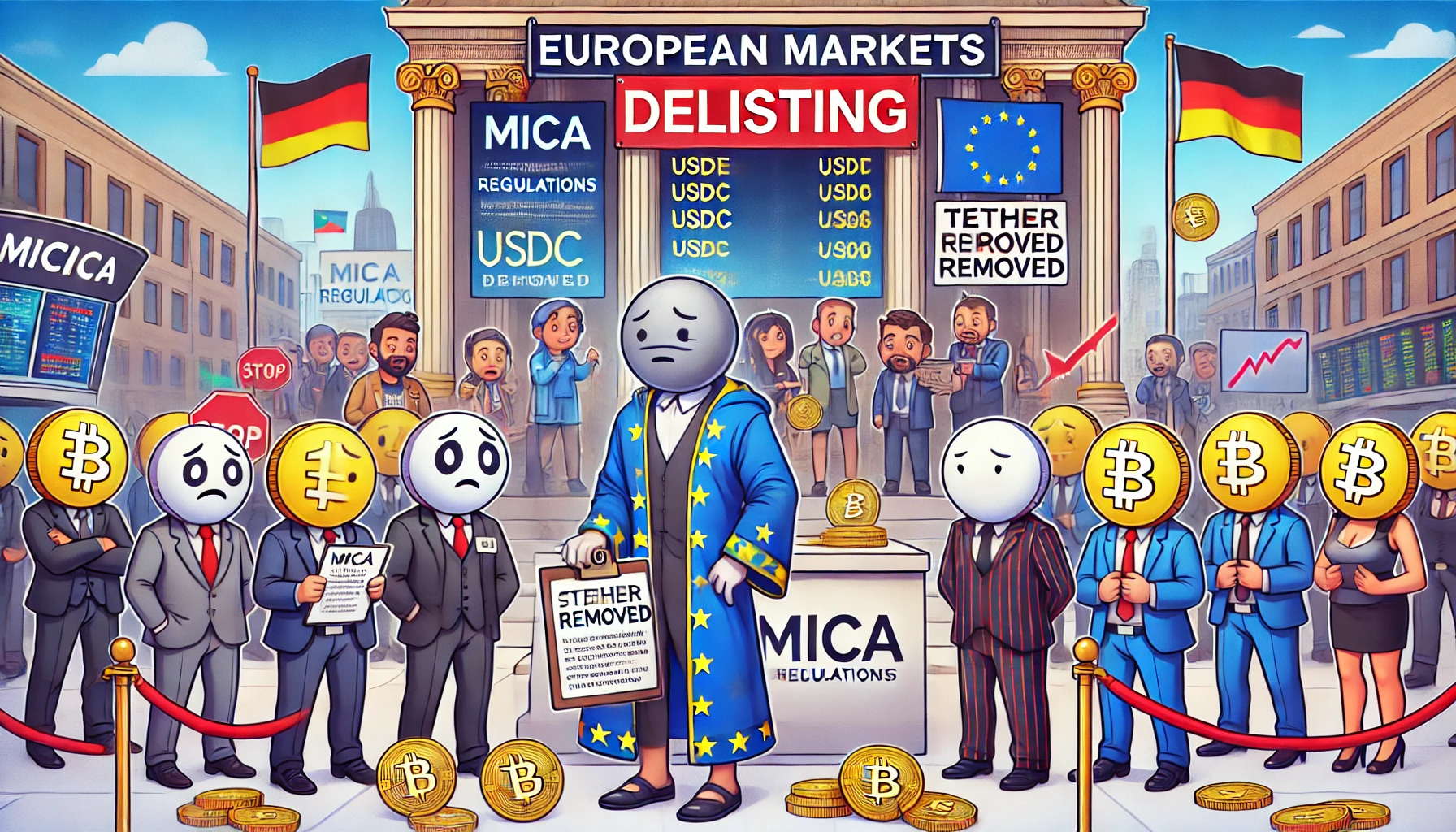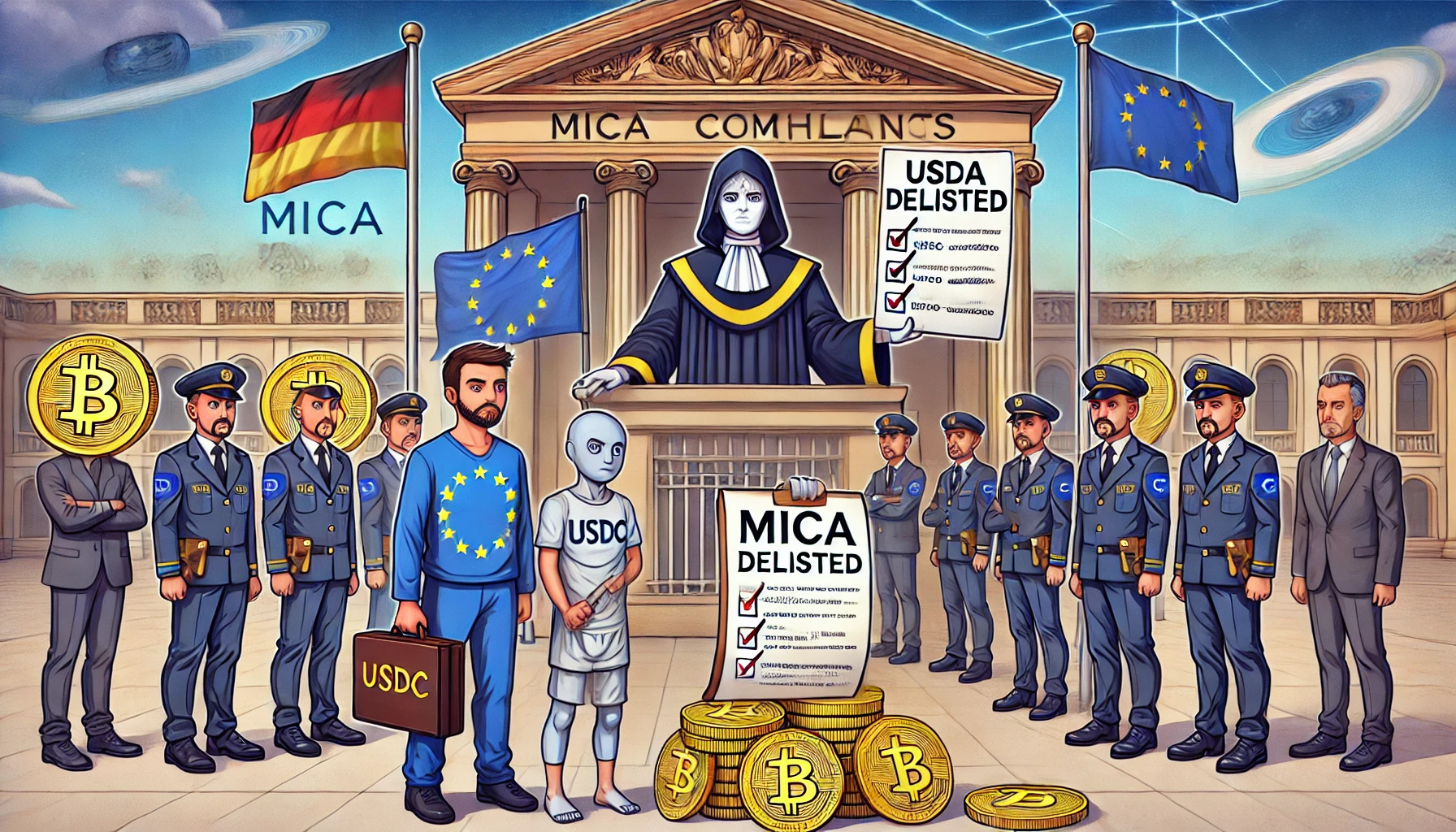The European Union’s Markets in Crypto-Assets or MiCA regulations just turned the stablecoin market upside down, and the fallout is already in motion. In a move that’s sending shockwaves across the crypto industry, major exchanges like Crypto.com and Coinbase are delisting Tether’s USDT from their Eurozone platforms—and that’s only the beginning.
If you’re wondering why the world’s largest stablecoin is suddenly being dropped in one of the biggest financial regions, you’re not alone. The industry is split on whether MiCA will revolutionize the crypto space—or send it into regulatory chaos.
So, is MiCA setting the stage for a more regulated, safer digital asset space? Or are we about to see a fragmented market that makes cross-border crypto transactions a nightmare? Let’s break it all down.
MiCA Regulations: The New Boss of European Crypto Markets
The European Union has always been ahead of the curve when it comes to financial regulations, and crypto is no exception. MiCA regulations, which are now in full effect for stablecoins and asset-referenced tokens (ARTs), aim to bring order to the wild world of digital assets.

At its core, MiCA regulations require exchanges to remove non-compliant stablecoins, which means USDT is getting booted from the Eurozone. And the biggest exchanges are already making moves.
- Crypto.com confirmed that it has dropped Tether (USDT) from its Eurozone platform.
- Coinbase, which recently received a MiCA license, has followed suit.
And that’s just the start—more platforms are expected to comply before the end of Q1 2025.
But what does that mean for traders, businesses, and the overall crypto ecosystem in Europe?
Why Is Tether (USDT) Being Delisted in Europe?
Tether (USDT) is the world’s most used stablecoin, with a market cap of over $95 billion. So why would the EU want to ban it from exchanges?
It all comes down to compliance.
MiCA regulations introduced stricter rules for stablecoins, ensuring that all digital assets meet the following criteria:
| Requirement | MiCA Compliance |
| Full transparency on reserves | ✅ Required |
| EU-based financial oversight | ✅ Required |
| Limited market impact on fiat currency | ✅ Required |
| Risk management frameworks | ✅ Required |
USDT doesn’t fully comply with all these new rules, making it a target for delisting.
Crypto exchanges in Europe now have until the end of Q1 2025 to remove non-compliant assets.
Industry Reactions: Divided Opinions on MiCA’s Impact
Not everyone is thrilled about Tether’s removal from the Eurozone. The industry is split down the middle, with some calling it a necessary step toward financial security, while others fear it will disrupt the market.
The Critics: “This Will Hurt Crypto Liquidity”
Tether CEO Paolo Ardoino has been one of the loudest critics, arguing that MiCA’s stablecoin crackdown could reduce liquidity and create systemic risks.
“Forcing traders to rely on alternative stablecoins complicates cross-border transactions and reduces overall efficiency,” Ardoino warned.
Crypto traders and DeFi protocols heavily rely on USDT, so this move could:
- Fragment liquidity makes it harder to move money quickly.
- Increase reliance on alternative stablecoins, which may not have the same liquidity as USDT.
- Introduce unnecessary complexity in an industry that thrives on efficiency.
The Supporters: “MiCA Is a Game-Changer for Compliance”
On the other side, some industry leaders believe MiCA regulations are exactly what the crypto market needs.
Marina Markezic, co-founder of the European Crypto Initiative, called it a revolutionary approach that streamlines compliance:
“Despite challenges, MiCA creates a great opportunity for crypto businesses to operate more efficiently across European markets.”

The “passporting” feature in MiCA could allow crypto businesses to operate across all EU countries under a single regulatory framework—potentially reducing barriers to entry.
But will it work in practice?
Switzerland vs. the EU: Which Crypto Model Wins?
To understand how MiCA could impact crypto’s future, it’s worth comparing it to Switzerland’s approach to digital assets.
Switzerland has long been a crypto-friendly haven thanks to its technology-neutral regulatory framework. Instead of restricting stablecoins like the EU, Switzerland takes a business-friendly stance that allows innovation to thrive.
Key Differences Between MiCA Regulations and Switzerland’s Crypto Laws
| Feature | MiCA (EU) | Switzerland |
| Stablecoin Oversight | Strict | Flexible |
| Regulatory Burden | High | Moderate |
| Market Entry Process | Complex | Streamlined |
| Impact on Crypto Firms | Restrictive | Innovation-friendly |
Andreas Glarner, a Swiss crypto law expert, believes MiCA will struggle to match Switzerland’s success.
“MiCA’s high compliance burden makes it hard for EU-based firms to compete globally.”
Translation? While MiCA regulations might create a safer market, it could also make Europe a less attractive place for crypto businesses.
Final Thoughts: A Turning Point for Stablecoins
The MiCA stablecoin crackdown is reshaping the crypto landscape, and the long-term effects remain to be seen.
- Will this lead to a more secure crypto market?
- Or will traders and businesses seek alternative solutions outside of the EU?
One thing’s for sure—2025 will be a defining year for stablecoins and crypto regulation.
Frequently Asked Questions (FAQs)
1. Why is Tether (USDT) being delisted in Europe?
MiCA regulations require stablecoins to meet strict compliance standards. USDT does not fully comply, so major exchanges are removing it.
2. Which exchanges have already delisted USDT?
Crypto.com and Coinbase have already dropped USDT from their Eurozone platforms, and more exchanges are expected to follow.
3. What is MiCA’s “passporting” feature?
It allows crypto businesses to operate across all EU countries with a single license, potentially reducing regulatory barriers.
4. Will MiCA Regulations impact USDT’s price?
While USDT remains dominant globally, its removal from European exchanges could affect its liquidity and usage in certain regions.
5. What stablecoins might replace USDT in Europe?
Euro-backed stablecoins like EUROC could see increased adoption.
6. Could the EU reconsider its stance on Tether?
This is unlikely, as regulators seem firm in enforcing MiCA’s compliance rules.
7. How does Switzerland’s crypto approach differ?
Switzerland has a technology-neutral framework, making it more innovation-friendly than the EU’s stricter approach.





























